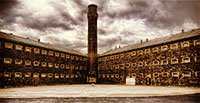 It’s a sign of how far Northern Ireland has come, in the last twenty years, that the once infamous Crumlin Road Gaol, in Belfast, is now a museum and visitor’s centre. The Victorian jail closed its doors as a prison in 1996, as part of the Northern Ireland Peace Process. Amongst its more famous inmates, in different periods were Eamon De Valera, Ian Paisley, Martin McGuinness, Michael Stone and Bobby Sands.
It’s a sign of how far Northern Ireland has come, in the last twenty years, that the once infamous Crumlin Road Gaol, in Belfast, is now a museum and visitor’s centre. The Victorian jail closed its doors as a prison in 1996, as part of the Northern Ireland Peace Process. Amongst its more famous inmates, in different periods were Eamon De Valera, Ian Paisley, Martin McGuinness, Michael Stone and Bobby Sands.
Official Site
 Killary Harbour is one of three glacial fjards that exist in Ireland ( the other two are Lough Swilly and Carlingford Lough).Running along the border between Galway and Mayo, in the heart of Connemara, the Fjard offers some of Ireland’s most striking scenery. Along its shores there are the towns of Rossroe and Leenane. It was near Rossroe, in 1948, Ludwig Wittgenstein stayed, in a cottage in , where he began writing MS 137.
Killary Harbour is one of three glacial fjards that exist in Ireland ( the other two are Lough Swilly and Carlingford Lough).Running along the border between Galway and Mayo, in the heart of Connemara, the Fjard offers some of Ireland’s most striking scenery. Along its shores there are the towns of Rossroe and Leenane. It was near Rossroe, in 1948, Ludwig Wittgenstein stayed, in a cottage in , where he began writing MS 137.
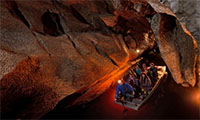 The Marble Arch Caves Geopark in Co. Fermanagh at the foothills of Cuilcagh Mountain is an unforgettable site to visit. A fascinating natural underworld of rivers, waterfalls, winding passages and lofty chambers – the caves are accessed by a 10 minute boat-ride, before you take a 1.5km walk through the cave system. A guided tour takes roughly 75minutes.
The Marble Arch Caves Geopark in Co. Fermanagh at the foothills of Cuilcagh Mountain is an unforgettable site to visit. A fascinating natural underworld of rivers, waterfalls, winding passages and lofty chambers – the caves are accessed by a 10 minute boat-ride, before you take a 1.5km walk through the cave system. A guided tour takes roughly 75minutes.
Official Site
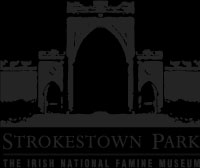 In the mid 1840s Ireland suffered a great famine which devestated the population, through starvation and emigration. The Strokestown Park Nation Famine Museum is a hugely important site to visit, to begin to understand the ramifications of the famine on Ireland’s history. The Famine Museum was opened in 1994 by the then President of Ireland, Mary Robinson, and she said ‘More than anything else, this Famine Museum shows us that history is not about power or triumph nearly so often as it is about suffering and vulnerability’.
In the mid 1840s Ireland suffered a great famine which devestated the population, through starvation and emigration. The Strokestown Park Nation Famine Museum is a hugely important site to visit, to begin to understand the ramifications of the famine on Ireland’s history. The Famine Museum was opened in 1994 by the then President of Ireland, Mary Robinson, and she said ‘More than anything else, this Famine Museum shows us that history is not about power or triumph nearly so often as it is about suffering and vulnerability’.
Official Site
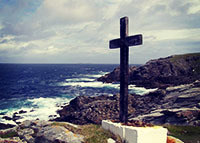 Malin Head, is located on the Inishowen Peninsula, County Donegal, Ireland and is the most northerly point of the island of Ireland.Malin Head is renowned for its rugged coastal landscape, attractive beaches and some of the biggest sand dunes in Europe at nearby Five Finger Strand from Knockamany Bens .
Malin Head, is located on the Inishowen Peninsula, County Donegal, Ireland and is the most northerly point of the island of Ireland.Malin Head is renowned for its rugged coastal landscape, attractive beaches and some of the biggest sand dunes in Europe at nearby Five Finger Strand from Knockamany Bens .
Official Site
The Ulster American Folk Park in Co. Tyrone brings to life the story of emigration from Ulster to America from the 18th Century onwards, and so helps illustrate an essential part of of Irish history. It’s often remarked that there are more people with Irish ancestry living outside the island of Ireland, than in Ireland itself, and this innovative park helps re-create the stories of generations of immigrants.
Official Site
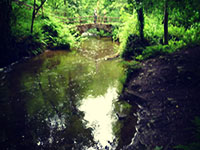 Dún na Rí Forest Park in Co. Cavan is 565 acre of wonderful Forest land stretching along the Cabra river valley. There are four different walks, each between 1.5km and 2km in length, with wildlife. Attractions include Ice House, Toba na Splinne Holy Well and Cromwell’s Bridge. It was at Dún na Rí, in Irish mythology, that the hero Cuchulain camped at night, while defending Ulster single-handedly from the invading armies of Queen Maeve of Connaught.
Dún na Rí Forest Park in Co. Cavan is 565 acre of wonderful Forest land stretching along the Cabra river valley. There are four different walks, each between 1.5km and 2km in length, with wildlife. Attractions include Ice House, Toba na Splinne Holy Well and Cromwell’s Bridge. It was at Dún na Rí, in Irish mythology, that the hero Cuchulain camped at night, while defending Ulster single-handedly from the invading armies of Queen Maeve of Connaught.
Official Site
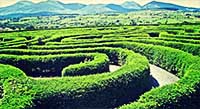 The Peace Maze, in Castlewellan Forest Park, Co. Down is one of the newest attractions in this list, dominated as it is by historic and ancient sites. Created in 2000, with community involvement, it’s a beautiful physical monument to the huge advances made, thanks to the efforts of both communities in Northern Ireland in the last twenty years. The Peace Maze is worth a visit in its own right, but the fact that its in the middle of the beautiful Castlewellan Forest Park is an added bonus, with its dramatic setting of mountains and sea.
The Peace Maze, in Castlewellan Forest Park, Co. Down is one of the newest attractions in this list, dominated as it is by historic and ancient sites. Created in 2000, with community involvement, it’s a beautiful physical monument to the huge advances made, thanks to the efforts of both communities in Northern Ireland in the last twenty years. The Peace Maze is worth a visit in its own right, but the fact that its in the middle of the beautiful Castlewellan Forest Park is an added bonus, with its dramatic setting of mountains and sea.
Official Site
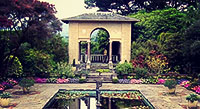 Garnish Island, in Glengariff – a sheltered harbour in County Cork’s Bantry Bay is home to an amazing planned garden, filled with rare and exotic plants that benefitfrom a unique micro-climate thanks in part to it’s own woodlands, the shelter of the harbour, and the proximity of the Gulf Stream. The Gardens are the result of the creative partnership of Annan Bryce and Harold Peto, architect and garden designer. The island was bequeathed to the Irish people in 1953, and was subsequently entrusted to the care of the Commissioners of Public Works. A ferry runs from April-October from Glengariff.
Garnish Island, in Glengariff – a sheltered harbour in County Cork’s Bantry Bay is home to an amazing planned garden, filled with rare and exotic plants that benefitfrom a unique micro-climate thanks in part to it’s own woodlands, the shelter of the harbour, and the proximity of the Gulf Stream. The Gardens are the result of the creative partnership of Annan Bryce and Harold Peto, architect and garden designer. The island was bequeathed to the Irish people in 1953, and was subsequently entrusted to the care of the Commissioners of Public Works. A ferry runs from April-October from Glengariff.
Official Site
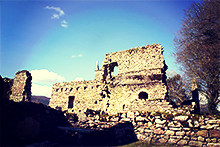 Just one of three separate themed itineraries in Co. Carlow, St. Moling’s Trail starts at Borris House, one of Leinster’s most impressive country houses, and weaves through Carlow to take in Temple Moling in Ballinree and the diminutive early medieval church at Killoughternane. It also includes the fine Cistercian Duiske Abbey (also known as Graiguenamanagh Abbey) in Co. Kilkenny.
Just one of three separate themed itineraries in Co. Carlow, St. Moling’s Trail starts at Borris House, one of Leinster’s most impressive country houses, and weaves through Carlow to take in Temple Moling in Ballinree and the diminutive early medieval church at Killoughternane. It also includes the fine Cistercian Duiske Abbey (also known as Graiguenamanagh Abbey) in Co. Kilkenny.
Official Site
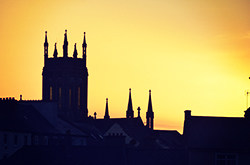 Kilkenny, one of Ireland’s liveliest and oldest cities, graced with a number of world-class festivals including the Kilkenny Arts Festival, The Cat Laughs Festival, and the Kilkenomics festival, is also the best place in the country to immerse yourself in Ireland’s Medieval past. Within short walking distance you can visit the 13th Century St Canice’s Cathedral (with an earlier, 9th century, round tower in its grounds), and the famous Kilkenny Castle, originally built in 1195 as part of the Norman Invasion of Ireland
Kilkenny, one of Ireland’s liveliest and oldest cities, graced with a number of world-class festivals including the Kilkenny Arts Festival, The Cat Laughs Festival, and the Kilkenomics festival, is also the best place in the country to immerse yourself in Ireland’s Medieval past. Within short walking distance you can visit the 13th Century St Canice’s Cathedral (with an earlier, 9th century, round tower in its grounds), and the famous Kilkenny Castle, originally built in 1195 as part of the Norman Invasion of Ireland
Official Site
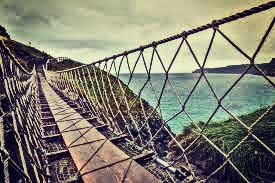 The Carrick-a-Rede rope bridge, in Co. Antrim was first erected by fishermen in 1775. The ‘Rock in the Road’ (Carraig a’ Ráid) island, was an obstacle in the migratory path of wild salmon, and so this place was particularly good for fishing. A new guided visitor experience helps provide a sense of place and connection with the famous rope bridge on the North Antrim coast.
The Carrick-a-Rede rope bridge, in Co. Antrim was first erected by fishermen in 1775. The ‘Rock in the Road’ (Carraig a’ Ráid) island, was an obstacle in the migratory path of wild salmon, and so this place was particularly good for fishing. A new guided visitor experience helps provide a sense of place and connection with the famous rope bridge on the North Antrim coast.
Official Site
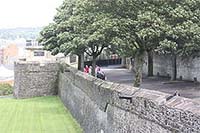 A trip to Derry is an absolute must for any visit to Ireland, and any trip to Derry must include a walk around its famed walls, originally built in the period 1613-1618, to protect English / Scottish settlers. The walls have played their part throughout Derry’s troubled history, defending the city during the famous siege of Derry. In more recent times they have become part of a heritage tour, that shows of one of Europe’s finest walled cities.
A trip to Derry is an absolute must for any visit to Ireland, and any trip to Derry must include a walk around its famed walls, originally built in the period 1613-1618, to protect English / Scottish settlers. The walls have played their part throughout Derry’s troubled history, defending the city during the famous siege of Derry. In more recent times they have become part of a heritage tour, that shows of one of Europe’s finest walled cities.
Official Site
Waterford Crystal is one of Ireland’s most famous brand-names, with the first official glass production taking place in the city back in 1783. Since then the company has had its ups and downs, but it remains a world-class brand, and it’s new visitor’s centre, in the heart of Waterford City, shows visitors the process of making the luxury crystal.
Official Site
In 148 B.C there was an Oak Road, built across the boglands of Co. Longford. The Corlea Trackway, the largest road of its kind discovered in Europe, was excavated by Professor Barry Raftery of University College Dublin. An interprative centre holds an eighteen metre section of the road, and explains its significance and the excavation work that is ongoing in the area. The Interprative centre is 3km outside Kenagh Village, Co. Longford.
Official Site
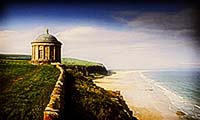 The combination of an Italian styled folley, the Mussenden Temple, perched over one of the finest beaches in Ireland, Downhill Strand, made this a perfect location for Game of Thrones, which filmed scenes from the second series here. The Mussenden Temple was built, in 1785, and modeled on the Temple of Vesta in Rome. Downhill Estate & Mussenden Temple are now managed by the Natonal Trust and are open to the public.
The combination of an Italian styled folley, the Mussenden Temple, perched over one of the finest beaches in Ireland, Downhill Strand, made this a perfect location for Game of Thrones, which filmed scenes from the second series here. The Mussenden Temple was built, in 1785, and modeled on the Temple of Vesta in Rome. Downhill Estate & Mussenden Temple are now managed by the Natonal Trust and are open to the public.
Official Site
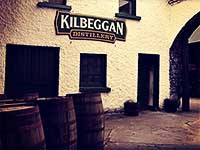 Kilbeggan is, for many people, synonymouse with Irish Whiskey, and today the Kilbeggan Distillery (the oldest licensed distillery in Ireland) offers visitors a chance to enter the distillery, to see how Irish Whiskey is produced, with the traditional method of mashing in oak mash tuns, fermenting in Oregon pine vats , and finally seeing the oldest pot still in the world.
Kilbeggan is, for many people, synonymouse with Irish Whiskey, and today the Kilbeggan Distillery (the oldest licensed distillery in Ireland) offers visitors a chance to enter the distillery, to see how Irish Whiskey is produced, with the traditional method of mashing in oak mash tuns, fermenting in Oregon pine vats , and finally seeing the oldest pot still in the world.
Official Site
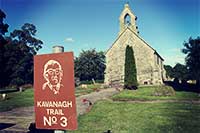 Patrick Kavanagh, one of Ireland’s most important poets of the 20th Century, dedicated much of his work to his home county of Monaghan, not all of it complimentary. For a long time the feeling was mutual, with little official recognition of the poet locally. Thankfully, today Kavanagh is recognised worldwide as a powerful and individual literary voice, and his heritage is fully commemorated in the Patrick Kavanagh Centre, in his native Iniskeen Co. Monaghan. Alongside the centre there is also a Patrick Kavanagh Trail, showing various locations from his fiction and poetry.
Patrick Kavanagh, one of Ireland’s most important poets of the 20th Century, dedicated much of his work to his home county of Monaghan, not all of it complimentary. For a long time the feeling was mutual, with little official recognition of the poet locally. Thankfully, today Kavanagh is recognised worldwide as a powerful and individual literary voice, and his heritage is fully commemorated in the Patrick Kavanagh Centre, in his native Iniskeen Co. Monaghan. Alongside the centre there is also a Patrick Kavanagh Trail, showing various locations from his fiction and poetry.
Official Site
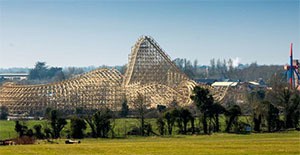 Tayto Park is one of those places that could only happen in Ireland. It’s a theme park based around a packet of crisps – although that’s simplifying it, in particular when you take into account the cultural power of Tayto crisps; It’s one of those brands that Irish people strongly associate Ireland with – we all grew up eating Tayto Cheese and Onion crisps, and from there, we arrive at Ireland’s first real theme park, with Ireland’s First rollercoaster and Europe’s largest wooden rollercoaster with an inversion – the Cú Chulainn Coaster!
Tayto Park is one of those places that could only happen in Ireland. It’s a theme park based around a packet of crisps – although that’s simplifying it, in particular when you take into account the cultural power of Tayto crisps; It’s one of those brands that Irish people strongly associate Ireland with – we all grew up eating Tayto Cheese and Onion crisps, and from there, we arrive at Ireland’s first real theme park, with Ireland’s First rollercoaster and Europe’s largest wooden rollercoaster with an inversion – the Cú Chulainn Coaster!
Official Site
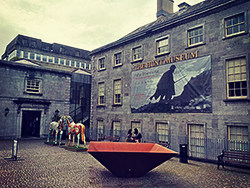 Limerick’s Hunt Museum, housed in the 18th-century former Customs House, exhibits one of Ireland’s greatest private collections of Art and Antiquities, dating from the Neolithic to the 20th Century. The Hunt Museum develops and provides many activities, such as Tours around the museum, Arts and Crafts Classes, Kids Activities, Camps and Lectures
Limerick’s Hunt Museum, housed in the 18th-century former Customs House, exhibits one of Ireland’s greatest private collections of Art and Antiquities, dating from the Neolithic to the 20th Century. The Hunt Museum develops and provides many activities, such as Tours around the museum, Arts and Crafts Classes, Kids Activities, Camps and Lectures
Official Site
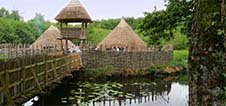 The Craggaunowen Pre-historic Park, , in Co. Clare explores Ireland’s Bronze age past, and in particular the Crannog settlements built in that time. A Crannog (or Crannóg in the original Irish form) was an artificial island settlement reached by a hidden pathway in the water. They were built for defensive purposes, and at Craggaunowen you can see an authentic re-creation. There is also a ring fort, and a 16th century castle to visit.
The Craggaunowen Pre-historic Park, , in Co. Clare explores Ireland’s Bronze age past, and in particular the Crannog settlements built in that time. A Crannog (or Crannóg in the original Irish form) was an artificial island settlement reached by a hidden pathway in the water. They were built for defensive purposes, and at Craggaunowen you can see an authentic re-creation. There is also a ring fort, and a 16th century castle to visit.
Official Site
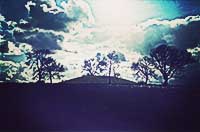 Emaın Macha or the Navan Fort in Co. Armagh (not to be confused with the town of Navan, in Co. Meath), was one of the great royal sites of pre-Christian Gaelic Ireland and the capital of the Ulaid (the tribes which would give their name to the province of Ulster). Today the Navan Center and fort hosts a great interprative centre, and a living history project where you can learn about Celtic Ireland and the legndary figures of Cu Chulainn, King Conchobar McNessa, Queen Mebh and Deirdre of the Sorrows
Emaın Macha or the Navan Fort in Co. Armagh (not to be confused with the town of Navan, in Co. Meath), was one of the great royal sites of pre-Christian Gaelic Ireland and the capital of the Ulaid (the tribes which would give their name to the province of Ulster). Today the Navan Center and fort hosts a great interprative centre, and a living history project where you can learn about Celtic Ireland and the legndary figures of Cu Chulainn, King Conchobar McNessa, Queen Mebh and Deirdre of the Sorrows
Official Site
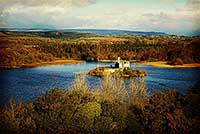 There has been a castle, on an island, in the picturesque Lough Key in Co. Roscommon from as far back as 1189 (we know this because, there is a mention of it in the Annals of Loch Cé, unfortunately pointing out that it was burned down on that date!). Throughout its history it passed through wo famous families,the Mc Greevy’s and the Mac Dermots. The current ruined Castle that visitors see is a folly built in the 19th Century by the King family, and destroyed shortly after the Second World War. Castle Island is just one of the attractions in the Lough Key Forest park which includes the Ice House, Gazebo, Ruined Church, Stables, Tunnels, the Bog Gardens, Wishing Chair, the Fairy Bridge, Drummans Bridge and the deer paddock. In addition, there are a number of short canals that are lined with walkways.
There has been a castle, on an island, in the picturesque Lough Key in Co. Roscommon from as far back as 1189 (we know this because, there is a mention of it in the Annals of Loch Cé, unfortunately pointing out that it was burned down on that date!). Throughout its history it passed through wo famous families,the Mc Greevy’s and the Mac Dermots. The current ruined Castle that visitors see is a folly built in the 19th Century by the King family, and destroyed shortly after the Second World War. Castle Island is just one of the attractions in the Lough Key Forest park which includes the Ice House, Gazebo, Ruined Church, Stables, Tunnels, the Bog Gardens, Wishing Chair, the Fairy Bridge, Drummans Bridge and the deer paddock. In addition, there are a number of short canals that are lined with walkways.
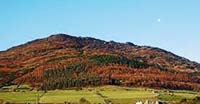 Slieve Foy is the highest point of the Cooley Mountain range, on the Cooley Peninsula in Co.Louth, which also hosts the charming fishing village of Carlingford – a favourite day-trip destination from Dundalk, and further afield (it’s easily reached from Dublin or Belfast). This is border country, and also the setting for the old Irish epic the Táin Bó Cúailnge (The cattle raid of Cooley). A great destination for walking (the peak is 585m), which on a good day offers views of Dundalk Bay, the Mourne Mountains, and even as far as the Wicklow Hills.
Slieve Foy is the highest point of the Cooley Mountain range, on the Cooley Peninsula in Co.Louth, which also hosts the charming fishing village of Carlingford – a favourite day-trip destination from Dundalk, and further afield (it’s easily reached from Dublin or Belfast). This is border country, and also the setting for the old Irish epic the Táin Bó Cúailnge (The cattle raid of Cooley). A great destination for walking (the peak is 585m), which on a good day offers views of Dundalk Bay, the Mourne Mountains, and even as far as the Wicklow Hills.
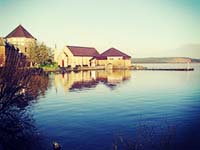 Station Island, Famed as St. Patrick’s Purgatory, a small island on Lough Derg, in county Donegal is synonymous for most Irish people with pilgramage, penitence, and prayer. The Island has been receiving pilgrims continuously for well over 1000 years. This is a place of reflection, and while nowadays there are a number of less harsh options for visiting the Island, rather than just the traditional 3 day pilgrimage (which involves bare feet, a 24hr vigil and fasting), the Island remains a laptop/mobile phone/mp3 player free zone. Organised spiritual retreats are on offer, but also self-directed ‘Quiet Days’ where you can escape the distractions of the modern world, and meditate in a truly special place.
Station Island, Famed as St. Patrick’s Purgatory, a small island on Lough Derg, in county Donegal is synonymous for most Irish people with pilgramage, penitence, and prayer. The Island has been receiving pilgrims continuously for well over 1000 years. This is a place of reflection, and while nowadays there are a number of less harsh options for visiting the Island, rather than just the traditional 3 day pilgrimage (which involves bare feet, a 24hr vigil and fasting), the Island remains a laptop/mobile phone/mp3 player free zone. Organised spiritual retreats are on offer, but also self-directed ‘Quiet Days’ where you can escape the distractions of the modern world, and meditate in a truly special place.
Official Site